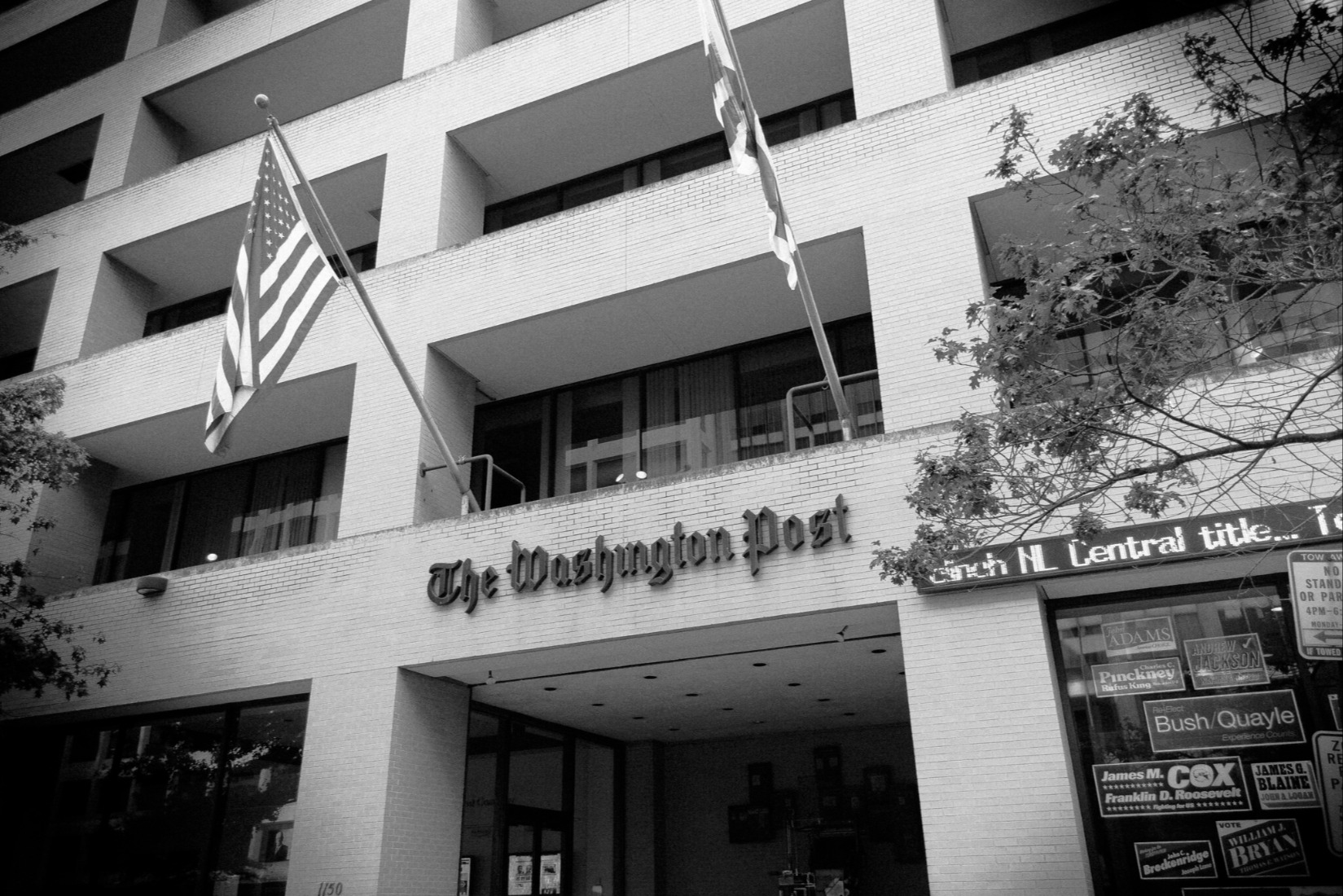The Dry Run: The Ouster of a County Official as an ‘Insurrectionist’ Creates Ominous Precedents for Trump
Though other courts have referred to the Capitol riot in passing as an “insurrection,” Judge Francis Mathew is the first to apply that term to the riot in a formal, rigorous way in a case against a New Mexico county official, Couy Griffin.

Published by The Lawfare Institute
in Cooperation With

A judge today removed a county official from office under Section 3 of the 14th Amendment, the hoary post-Civil War provision that bars certain people from holding office if they have “engaged in insurrection” against the United States.
Judge Francis Mathew, of the First Judicial District Court in Santa Fe, ousted Otero County (N.M.) Commissioner Couy Griffin, due to his involvement in the Jan. 6, 2021, Capitol riot. According to lawyers who brought the case, it represents the first time a court has disqualified an official under Section 3 since 1869. (Congress refused to seat a U.S. congressman, Victor Berger, under the section in 1919.)
Mathew’s 49-page ruling also marked the first formal judicial finding that the Capitol riot amounted to an “insurrection” within the meaning of that constitutional provision.
The decision could have enormous repercussions for the nation’s next presidential race, as advocacy groups have vowed to try to bar Trump from appearing on state ballots on the grounds that his role in instigating the Capitol riot disqualifies him from holding federal office.
Asked by Lawfare for comment, Griffin, who represented himself in the case, said in an email: “Perfect example of tyranny. To use the civil courts and the ruling of a liberal district court judge to subvert the will of the people who already spoke thr[ough] a failed recall [vote] is tyranny in its purest form. Maybe this is the start of the Biden regime[’]s war on ultra maga Americans.”
At a bench trial last March, federal prosecutors in Washington, D.C., convicted Griffin of the federal misdemeanor of entering and remaining in a restricted zone. At the same time, however, the trial judge, U.S. District Judge Trevor McFadden, acquitted Griffin of a second misdemeanor charge: disorderly conduct within a restricted zone.
Judge Mathew, in the Section 3 case in Santa Fe, found that there was no requirement for an official removed under Section 3 to first be convicted of any criminal offense and that, indeed, “neither the courts nor Congress have ever required a prior criminal conviction for a person to be disqualified under Section Three.”
Last March, lawyers for three New Mexico residents brought a so-called quo warranto action against Griffin—a common-law cause of action for challenging the qualifications of an elected official. The case culminated in a two-day bench trial last month. Today’s ruling closely tracks the plaintiffs’ proposed findings of fact and conclusions of law, filed Aug. 29. (Griffin filed a two-page, written “closing argument” that same day, arguing inter alia that his conduct was protected by the First Amendment.)
Though other courts have referred to the Capitol riot, in passing, as an “insurrection,” Mathew is the first judge to apply that term to the riot in a formal, rigorous way, after having specifically defined its meaning in the context of Section 3.
Although advocacy groups have brought at least 11 formal Section 3 challenges to various elected officials since Jan. 6, 2021—targeting such prominent public figures as then-Rep. Madison Cawthorn, Rep. Marjorie Taylor Greene, and Sen. Ron Johnson—most of those have already definitively failed.
Griffin, however, is the first target who unambiguously participated in criminal conduct, at least to the extent of breaching the restricted zone surrounding the Capitol, climbing over multiple barriers, and stoking the crowd with a bullhorn from the besieged inaugural platform. However, he did not enter the Capitol, nor was he personally accused of engaging in violence.
But a second distinctive aspect of this particular trial—just as important—is that the lawyers for the challengers in this instance presented remarkably authoritative, scholarly testimony establishing that “knowledgeable people in the Nineteenth Century” would have counted the Capitol riot as an “insurrection” and would have considered Griffin’s conduct—though nonviolent—as amounting to “engaging in” such an insurrection.
This testimony came from Mark Graber, a Regents Professor at the University of Maryland Law School, who has taught American political and constitutional history for 30 years. To arrive at an understanding of 19th century understandings of those terms, he testified, he “read the entire Congressional globe as well as the Journal of the Joint Committee on Reconstruction, which was responsible for drafting specific language.” He also “looked particularly at various drafts of Section 3,” and “why it changed and sometimes why it didn’t change.” He also “looked at events before 1866 trying to figure out how Americans at the time used words,” spending particular time “on loyalty oaths.”
Finally, he drew upon comprehensive databases to examine every use of the word “insurrection” in judicial opinions, presidential proclamations, and legal treatises from circa 1789–1876. In his testimony, he identified a “broad consensus” on what insurrection meant and what “engaging in” one entailed.
Today, Judge Mathew adopted Graber’s definitions in finding that Griffin’s conduct amounted to “engaging in insurrection,” even though Griffin had not personally engaged in violence.
Importantly, Griffin proceeded pro se at trial. (He was represented for a period during the pretrial phase.) As a consequence, he did not raise all of the legal arguments that a legal team might have. I have written about those very significant potential hurdles here.
In a nutshell, here’s what Griffin did, according to today’s ruling. In late December 2018, Griffin took an oath to defend the U.S. Constitution in preparation for assuming his office as county commissioner in 2019. (Under Section 3, such an oath is a necessary triggering event before anyone becomes subject to the disqualification provisions of that section.)
Later in 2019, he founded a group called Cowboys for Trump. After Trump lost the presidential election in November 2020, Griffin and his organization “played a key role in the Stop the Steal movement’s mobilization efforts ahead of the January 6, 2021 attack on the Capitol,” according to Judge Mathew.
As he drove across the country to Washington, Griffin spoke at numerous rallies, employing highly belligerent rhetoric as he recruited others to come to the Jan. 6 rally. Griffin took a videographer with him on his trip, Matt Struck, who made videos of Griffin’s speeches, actions, and even informal chats on the way to Washington and back. Many of these were turned over to the plaintiffs during discovery and introduced by them in court.
Griffin, whom the plaintiffs called as a hostile witness, also admitted having brought three firearms with him to Washington, D.C.—two pistols and a lever-action rifle.
According to Judge Mathew, during the pre-rally tour Griffin “aided the Stop the Steal mobilization and recruitment efforts with increasing fervor, calling on crowds to come to Washington, D.C., on Jan. 6 and join the ‘war’ and ‘battle’ over the presidential election results.” (Some of the videos used by plaintiffs are included on an evidence page available here.)
On Jan. 3, for instance, in Bowling Green, Kentucky, he said: “The elitist, gross, wicked, vile people that are in place will continue to wage war on America. Because there is a war, mind you, I promise you that. ... [W]e got to get our country back. There’s no other way, there’s no other option.”
On that occasion, he also acknowledged that “there might be some of us that might lose our lives.”
The next day, in Atlanta, he called for “men from across our nation to come to Washington, D.C. on January 6, because it might be a battle. … If it comes down to a fight, if it boils down to what it could come to, we’re gonna need men standing strong shoulder to shoulder.”
On the way to Washington on Jan. 5 he said, “Losing is not an option. … Every card is on the table. Every option is available. And we feel that we are a nation at war right now and we are men that are answering the call.”
On Jan. 6, according to video evidence the plaintiffs presented, Griffin breached multiple security barriers and made his way up to the inaugural platform on the Lower West Terrace, where pepper spray and other chemical irritants were in the air. A video captured him saying, “I love the smell of napalm in the air”—an allusion to the Apocalypse Now line.
Then, in a video he made for his social media followers, Griffin said from the platform, “It’s a great day for America! The people [are] showing that they’ve had enough. People are ready for fair and legal elections, or this is what you’re going to get, and you’re going to get more of it.”
Not far from Griffin at that time, also on the Lower West Terrace, some of the most brutal fighting of Jan. 6 was taking place at the so-called tunnel archway—the ceremonial tunnel through which, during modern inaugurations, the president-elect strides onto the inaugural stage. That is where, on Jan. 6, 2021, Metropolitan Police Department Officer Daniel Hodges was famously crushed in a doorway, while rioters chanted “Heave-ho, heave-ho,” as they tried to push their way through into the Capitol basement.
Later, after Griffin left Washington, he made further damaging admissions in videos his hired videographer took of him. Three days after the riot, for instance, Griffin not only admitted having heard the “heave-ho” chants, but claimed to have joined in: “It was funny, whenever those guys—all those guys were down there on that one line where they were trying to push into the Capitol, and everybody that was gathered in the dome area, we were all screaming ‘Heave! Ho! Heave! Ho!’”
In another video excerpt, Griffin claimed to have seen windows being broken, too—with seeming approval. “I watched it all,” he said. “I saw some windows getting broken out of the Capitol and I saw some people pushing on police officers down below.”
In still another video made the day after the riot, he sounded proud to have been a part of a historic day. As the the judge recounted the evidence:
He gloated that he “climbed up on top of the Capitol building” and “saw a little bit of that action on … the inside.” ... He characterized the mob as “unleashing [the] whirlwinds” and a “shot over the bow.” ... He explained the purpose of the attack was to stop the transfer of presidential power and threatened further action to achieve that goal, stating, “[y]ou saw America rise up. … You saw a people that had had enough … because we will not lose. And Joe Biden will never be President … you thought yesterday was a big day? It’ll be nothing like — compared to like the next one.” ... Griffin previewed a more brutal attack to prevent Biden from taking office, stating “You want to say that was violence? … No, we could have a Second Amendment rally on those same steps that we had that rally yesterday, you know, and if we do, then it’s going to be a sad day because there’s going to be blood running out of that building.
Insurrection and Engaging in Insurrection
In applying Section 3 to these facts, Judge Mathew accepted Graber’s testimony regarding what “a knowledgeable nineteenth century” person would have understood by the terms “insurrection” and “engaging in” one. As for insurrection, he wrote:
The term “insurrection,” as understood by knowledgeable nineteenth-century Americans and Section Three’s framers, referred to an (1) assemblage of persons, (2) acting to prevent the execution of one or more federal laws, (3) for a public purpose, (4) through the use of violence, force, or intimidation by numbers. ... Judges, members of Congress, presidents, and legal experts from the era described as insurrections events such as the Whiskey Insurrection (1794) and Fries’ Insurrection (1799), which involved efforts to resist the federal government’s right to impose or collect certain taxes. ... Section Three’s framers and nineteenth-century Americans did not understand an insurrection to require actual violence; intimidation by numbers sufficed. … Thus, Fries’ Insurrection was considered an insurrection even though there was only intimidation and not actual violence. A tax collector fled when marched upon by angry Pennsylvania farmers, but “there was no evidence that anyone fired a shot, anyone threw a stone, anyone threw a punch.”
The Capitol riot met all four of the criteria for an insurrection, Mathew held, since thousands of people were acting to prevent execution of the election laws—the 12th and 20th Amendments and the Electoral Count Act—through use of force, violence, and intimidation. (“Public purpose” here means that the rioters were not out for themselves—trying to steal, say, furniture inside the Capitol to take to their homes—but were, rather, trying to reinstall their favored candidate as president.)
As for the “engage[s] in” language, Mathew also accepted Graber’s testimony, and reached these conclusions:
The case law holds that a person “engage[s]” in an insurrection within the meaning of Section Three by “[v]oluntarily aiding the [insurrection], by personal service, or by contributions, other than charitable, of anything that [is] useful or necessary” to the insurrectionists’ cause. ... [K]nowledgeable nineteenth-century Americans understood that a person “engaged in” insurrection whenever they were “leagued” with insurrectionists—either by acting in concert with others knowing that the group intended to achieve its purpose in part by violence, force, or intimidation by numbers, or by performing an “overt act” knowing that act would “aid or support” the insurrection. … One need not personally commit acts of violence to “engag[e] in” insurrection. ... Engagement thus can include non-violent overt acts or words in furtherance of the insurrection. … Under the nineteenth-century understanding, “an overt act is not measured by how much it contributes” to the insurrection; in the context of a violent insurrection such as the January 6 Attack, just “[o]ne more person closer to the Capitol” or “one more voice” encouraging violence would be “one more person” engaged in the insurrection.
Under these definitions, Mathew found that Griffin had engaged in “overt acts” in furtherance of an insurrection. Nor was Griffin’s fairly minor, nonviolent role a defense, as he saw it. The plaintiffs had called Daniel Hodges—the officer crushed in the door at the Lower West Terrace tunnel archway—as a witness to explain the important role that nonviolent rioters played in overwhelming the police. Citing excerpts from Hodges’s testimony, Mathew wrote:
Law enforcement’s efforts to secure the Capitol building were impeded by violent and non-violent members of the mob alike. ... Police officers could not tell in the moment which individuals were going to be violent; every trespasser within the restricted area was a potential threat and needed to be treated as such. … Non-violent members of the mob camouflaged violent members of the mob and contributed to law enforcement being overwhelmed by a “sea of potential threats.” … Every trespasser took up space and made it harder for law enforcement to defend the Capitol building and disperse the mob away from Capitol grounds.
Where Do We Go From Here?
In fairness, today’s ruling still leaves open questions—especially because Griffin was acting pro se. Many of the legal and constitutional questions that critics of Section 3 challenges have raised in other contexts were not raised here, or were not raised as skillfully as they could have been. Many of these issues are likely not waivable, so Griffin—with help, perhaps, from conservative “friend of the court” briefs—might yet be able to raise some of these himself in an appeal.
Still, today’s ruling shows that Section 3 is hardly a dead-letter, and Judge Mathew makes a strong case—backed by extremely solid scholarship—both that the Capitol riot was an “insurrection” within the meaning of that provision and that nonviolent rioters could well have “engaged in” it.





